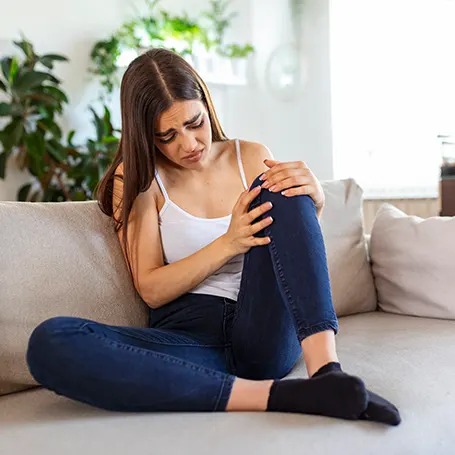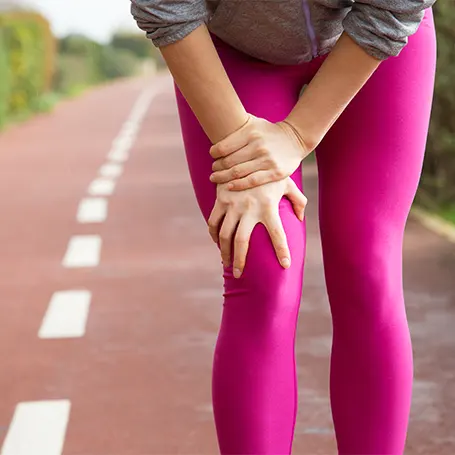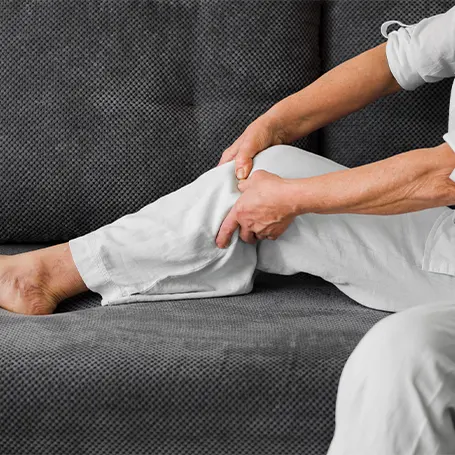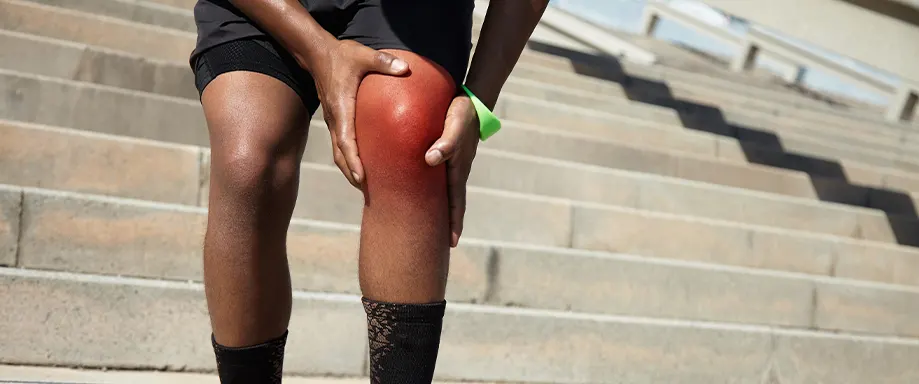The causes of throbbing leg pain when lying down

Why does sharp pain in the knee occur? It happens due to the deterioration of the cartilage, so the joints rub against each other. This is usually due to ageing, but it doesn't have to be. Sometimes the causes of knee injury are stress (for example: during exercise). If you ask yourself what can cause knee pain without injury – the answer is autoimmune processes such as rheumatism or arthritis.
Okay, you won't get a diagnosis for your problem here, but we can partially solve it. You need quality sleep, and with pain, it is almost impossible. First, you need to find the cause of the pain to solve the problem. Next, we can move on to remedying the consequence – a bad dream. Well, let's start with the basics.
Arthritis and joint inflammation
This is a degenerative knee condition, and it refers to the wear and tear of the knee cartilage. It is characterized by pain that gradually increases, leading to mobility issues (creaking knees, reduced range of motion, knee deformity). Sometimes it causes inflammation – hard swelling as a result of inflammation. This is why you may experience waking up during the night due to sharp knee pain.
Two common types of arthritis and knee arthritis pain are:
- Knee osteoarthritis – the most common type, a progressive condition that results from the gradual wear and tear of cartilage in the knee and usually occurs after middle age
- Rheumatoid arthritis – an inflammatory autoimmune disease that can occur at any age, affects other joints and affects several other body systems
Arthritis can also develop after a knee injury, which would be a post-traumatic consequence of an injury to the meniscus and ligaments. The reason can also be a knee fracture, and symptoms sometimes appear only after several years.
Ligament and other injuries
The ligament in the knee should provide stability and helps control the forward movement of the tibia. Athletes are most exposed to injuries, but it can happen to anyone. If you feel pain, swelling, or reduced mobility and you cannot find a comfortable sleep position, you should see a doctor.
The problem can also be a meniscus tear, patellar tendinitis (Jumper's Knee), bursitis, iliotibial band syndrome or patellofemoral pain syndrome (Runner's Knee). If you are going through all of these, avoid activities that can only worsen the condition. Try managing pain by using painkillers, pillows or cushions for the knee, as well as other techniques.
Tendinitis and bursitis
The bursa is actually a “bag” filled with fluid that enables frictionless movement. When certain parts become inflamed, bursitis occurs – thickening of the bursa and large amounts of fluid appear. This is the name for inflammation and swelling in the area of the front of the knee (at the level of the cup). In addition to the swelling, other symptoms, such as redness and a feeling of warmth, may occur.
Because of this, the knee is very painful to the touch, and the movements are limited, making it difficult to find a suitable sleeping position. It most often occurs in people who spend a lot of time in the kneeling position. Still, it can be the result of an injury, bacterial infection or repeated mechanical irritation.
Tendinitis is inflammation of a tendon (thick cord-like structure that connects muscles to bones). In order to manage knee pain caused by tendinitis and bursitis, try to rest as much as possible. Using therapies that reduce inflammation and pain will also be beneficial. Once you have a treatment plan from your doctor, address your sleeping environment.
Preparing your sleeping environment
When we said we would solve your problem, we meant this! You can't unlock dreamland without a comfortable sleep environment even with proper therapy. Now you might be thinking – oh, but I have everything I need. Well, it's time to raise your standards if you want to sleep like royalty. For starters, let's get rid of the uncomfortable bed!
Choosing the right mattress for knee pain relief
To choose a suitable mattress, you should pay attention to several key features:
- Firmness level – everyone with a problem with knee pain should try a medium-firm mattress that provides enough support for the whole body.
- Material – memory foam and latex mattresses will best adapt to any body shape, which means they can provide good support for throbbing knee pain relief
- Edge support – to get out of bed easier, look for a mattress with stable edge support to prevent sagging or sinking
- Motion isolation – if you don't sleep alone, any movement can create discomfort in the knees, so look for the motion isolation feature
- Trial period and warranty – test the mattress at home to be 100% sure it fits your specific needs
Adjustable beds and their potential advantages
It is specially designed to target specific problematic areas, such as your knee. It works on a simple principle – a flexible base supports your knee across all body parts. What does it actually look like? One of the most significant advantages is elevating the legs (or head).
In this way, you feel a temporary relief that gives you a better nights sleep. If you have mobility issues, you can also choose beds with features like wall-hugging technology or under-bed lighting. What we love most about this bed is that you can change the sleep position with minimal effort. That's why you will surely find the most comfortable position for sleeping!
Knee pillows
You can roll up a larger towel, use a pillow you already have at home, or buy a specially designed knee pillow (wedge pillow). During the night, while we sleep, our body relaxes. Therefore, the position of the legs is not in the correct position and strains the spine. The function of the knee pillow is to keep the legs in the correct position.
It should be placed slightly above the knee, and the best choice of padding is memory foam. Such a pillow will best adapt to your body, while the hollow foam will allow air to circulate. So hot sleepers won't feel it! If you are not comfortable enough with one pillow, add another one. You will place it a little above the foot.
Sleep positions for knee pain relief
Chronic knee pain is often not related to a single event. Picture this: you injured yourself in training and applied the appropriate therapy, but things are still not improving. Even your doctor tells you to be patient because the condition is not serious. Well, maybe some sleep position got its fingers involved?
So, your sleeping position can slow down or worsen the healing process. Before you go to sleep tonight, think about the pros and cons of certain sleeping positions.
Side sleeping with knee pain
The easiest way to prevent this is to put a thin pillow between your knees. If none of the pillows you have fit you, consider a wedge pillow. It is specially designed to adapt to your body and is used by side sleepers and back sleepers alike. We recommend purchasing a model with a fixing strip to prevent the cushion from moving.
Thus, the spine and hips are in a good position, and the pressure on the knees is reduced. Finally, knee pain is sometimes caused by our knees touching each other at night.
Back sleeping with knee pain
Are you a back sleeper? Oh, your skin texture will thank you for it (no wrinkles). But your knees will experience even more benefits. While lying flat on your back, put a pillow or cushion under your knees. That way, you will reduce pressure on your knee joints and provide support. For even better results, take the elevated leg position and further reduce pain in back of knee. Place a few pillows or cushions under your leg while you are on your back, as this will reduce swelling.
Avoiding stomach sleeping
This is definitely one of the worst sleeping positions, even if you don't have any problems – but don't worry, stomach sleeping will quickly create them. To begin with, this position increases pressure on the knees, which leads to discomfort and potential aggravation of existing knee issues. In addition, pressure also occurs on the lower back, which creates stress on the lumbar region. You can feel discomfort in the knees because they are connected through the body's kinetic chain.
Incorporating Stretching and Exercise

What is the best thing we can do for ourselves right now? To strengthen the muscles that support the knee and make it more flexible. You will do this with proper stretching and exercise. Start the exercise slowly, with a light warm-up, and then follow the following steps:
- Do squats – there are many variations (with legs together, apart, in a step)
- Lift your heels off the edge – stand facing support such as a sturdy chair or wall bar, then alternately lift and lower your heels
- Do a step-up exercise – place one foot on the platform, bend the knee, and slowly lower the opposite foot to the floor
- Try the lateral leg raise – lie on one side, bend the leg that will support you, straighten the other leg and lift it up (angle of 45 degrees)
When it comes to stretching, we recommend exercises that will strengthen the ankles, hamstrings and feet. For example, you can stand on a step or curb with the front of your foot and slowly lower your heels until you feel a slight stretch. Try to keep your spine in a neutral position and keep your arms supported.
However, if your knees hurt so much that bending them is almost impossible (pain on the inside of the knee) – we have an exercise for that too. Lie on the mat on your stomach and use the stretching band by hooking it to one foot and pulling it towards you with both hands.
If you feel pain above the knee cap, that could be a tendon, so be careful. See a physical therapist or sports medicine physician if any of these exercises make knee pain worse.
Pain management techniques for sleep
In order to get pain relief, relaxation, comfort, and avoid poor sleep you need effective management techniques. Consider a combination of medications, low-impact activities like swimming, and proper sleeping conditions. Yes, that should do the job – if you do everything right. We singled out several pain management techniques for each case and described each. So you can't go wrong!
Over-the-counter pain medications
If you, like some of us, have a low tolerance for pain, we recommend painkillers. This will reduce inflammation and pain. Don't forget that many topical gels or mousses also contain ibuprofen, which reduces swelling. However, it is okay to use the medicine to relieve knee pain only for a few days. But, if the symptoms still occur, you should contact your doctor.
Topical creams and gels for localized relief
Using a smaller dose, direct application to the painful area and greater safety are just some of the advantages of local analgesics. They can also have an anti-inflammatory, anti-arthritic effect, as well as promote the process of tissue regeneration and healing. They work by the fact that the skin absorbs the active ingredients, and they promote microcirculation in the treated area. What is actually going on there? Ingredients from topical gels block the production of enzymes that produce inflammatory chemicals – pain and swelling.
Ice and heat therapy for acute pain management
While ice packs can help reduce inflammation and numb the area, heat packs can relax muscles and alleviate stiffness. Therefore, heat therapy improves circulation and blood flow to a particular area. It can be applied in three ways:
- Dry heat – using heating pads, dry heating packs or saunas
- Moist heat – using steamed towels, moist heating packs or hot baths
- Professional heat therapy treatments – for example, heat from an ultrasound to improve blood flow
For acute knee pain (especially post-injury pain), cooling therapy can greatly affect pain. However, avoid applying ice directly to the affected area, as it can cause burns. Using a thin cotton cloth over which you will apply frozen cryogels is best.
Tip: Avoid these types of therapy if you have a higher risk of burns, open wounds or complications due to heat/cold application.
Implementing a Bedtime Routine

First and foremost – establish a consistent bedtime because good sleep hygiene is so important.
I know, I know… you're in pain. Nevertheless, think about how much time you want to allocate to your bedtime routine and prepare for sleep at least half an hour to an hour earlier. Even if you don't sleep, you will send your body a clear signal – it's time to sleep. Over time, it will understand what you are telling it, and you will manage to regulate the body's internal clock and promotes better sleep. To make this easier for you, create a relaxing environment.
What does not help are stimulants like caffeine or alcohol. Not only can they keep you awake, but they will wake you up to go to the bathroom at night. Finally, stick to the routine no matter how hard it is because consistency is the key to success. On the other hand, personalize your night routine according to your preferences and choose what relaxes you the most.
When to seek professional help
Knee joint pain is a temporary condition if it is not a chronic disease. However, there is one more thing that further complicates everything. Certain symptoms are the same as in deep vein thrombosis. Since pain can come from various conditions, it's often best to see a doctor for help. On the other hand, some people are more prone to these ailments. For example, these are athletes whose ligaments are often under attack, burst and tear.
Iliotibial band syndrome often occurs in people who regularly run or cycle for recreation. Fortunately, it usually pops up when the injured area is warmed up unless the injury is serious. Then the pain becomes more intense, requiring medical help and sometimes some interventions. Speaking of treatments, physical therapists, in collaboration with orthopaedic specialists, will identify the underlying causes and contributing factors to develop a personalized treatment plan.
They also use various techniques and bandages to improve joint mobility and reduce muscle tension. In this way, all future injuries are prevented. If conservative treatments (medications, injections, braces, and physical therapy) are ineffective for chronic pain, experts may recommend surgical procedures such as ligament repair, meniscus surgery, or knee replacement.
Conclusion
Therefore, knee pain at night is even more distressing because it affects sleep quality and can lead a person into a vicious cycle of knee pain and insomnia. It can occur during the night, even in perfectly healthy people. This is mainly due to the action of several different factors, such as intense physical activity and long-term sitting in a bad body position. So, try to maintain sleep hygiene and find a way to manage your knee pain. Try multiple approaches to relieve pain, as they work differently for everyone. Don't forget sleep is vital for body regeneration!













There are no comments yet
"*" indicates required fields